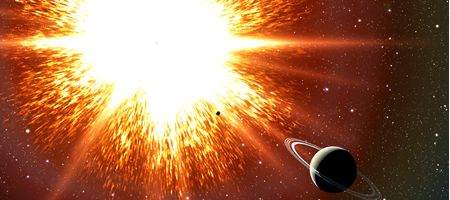Astrophysicist Rosanne Di Stefano compares it to the Hollywood blockbuster ‘Speed’ – a newly-described type of star that’s destined to explode if it slows down.

Her research shows that some old stars may be maintained by their rapid spins, so that when they slow down, they explode as supernovas. Thousands of these ‘time bombs’ could be scattered throughout our galaxy, she says.
“We haven’t found one of these time bomb stars yet in the Milky Way, but this research suggests that we’ve been looking for the wrong signs,” says Di Stefano, of the Harvard-Smithsonian Center for Astrophysics (CfA).
“Our work points to a new way of searching for supernova precursors.”
Type Ia supernovas occur when old, compact stars known as white dwarfs destabilize. These are stellar remnants that have ceased nuclear fusion and which can weigh up to 1.4 times as much as our sun. Any heavier, and gravity overwhelms the forces supporting the white dwarf, compacting it and igniting runaway nuclear fusion that blows the star apart.
There are two possible ways for a white dwarf to exceed their critical mass – known as the Chandrasekhar mass – and explode as a Type Ia supernova. It can accrete gas from a donor star, or two white dwarfs can collide.
The first scenario is more likely. But, if it’s correct, we would expect to see certain signs, such as small amounts of hydrogen and helium gas near the explosion – and for most Type Ia supernovae, we don’t.
Di Stefano and her colleagues suggest that spin could be the answer. A spin-up/spin-down process would introduce a long delay – as much as a billion years – between the time of accretion and the explosion.
As a white dwarf gains mass, it also gains angular momentum, which speeds up its spin. If it rotates fast enough, its spin helps support it, allowing it to cross the 1.4-solar-mass barrier.
Once accretion stops, the white dwarf will gradually slow down. Eventually, the spin isn’t enough to counteract gravity, leading to a Type Ia supernova.
In our galaxy, scientists estimate that there are three Type Ia supernovae every thousand years. If a typical super-Chandrasekhar-mass white dwarf takes millions of years to spin down and explode, then calculations suggest that there should be dozens of pre-explosion systems within a few thousand light-years of Earth.
Thy’ll be difficult to detect. However, upcoming wide-field surveys conducted at facilities like Pan-STARRS and the Large Synoptic Survey Telescope should be able to spot them.
“We don’t know of any super-Chandrasekhar-mass white dwarfs in the Milky Way yet, but we’re looking forward to hunting them out,” says co-author Rasmus Voss of Radboud University Nijmegen, The Netherlands.






